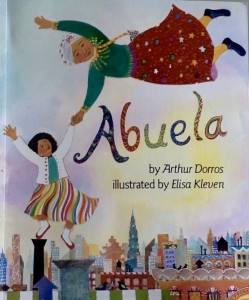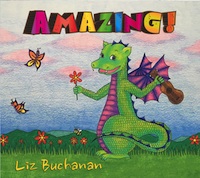 Ever dream of flying? Not flying on an airplane, though I love that, too. I mean letting your body catch the wind as you rise up into the air, soaring and gliding and seeing the sights far below.
Ever dream of flying? Not flying on an airplane, though I love that, too. I mean letting your body catch the wind as you rise up into the air, soaring and gliding and seeing the sights far below.
The classic Peter Pan fired children’s imaginations about flying. Just a little fairy dust, and off you can go, to a magical land beyond the horizon. A contemporary picture book about a flying adventure is Abuela, by Arthur Dorros, illustrated by Elisa Kleven.
I first read this book at part of an “Adventures” reading unit for kindergarteners; it’s a wonderful book for ages 4-7. An added bonus is that it includes many words and phrases in Spanish, as a young Latina, Rosalba, goes flying around the city with her grandmother, her abuela.
My song “Flying High,” from my new album Amazing is the perfect complement to this book, or to any book about flying. This song is available at my web page through CDBaby or Songs for Teaching.
I wish I knew how to fly, like fairies, birds and Superman!
If I could fly, I’d go so high, and with magic, I think I can! I think I can!
Two of the song’s three verses pose open-ended questions about flying:
- If we could fly, where would we go?
- If we could fly, what would we see?
The song answers the questions, but of course, there are many other possible answers. Writing a new verse to the song could be a creative extension of the Abuela story for the class. It is also a way for students to learn and practice writing in the genre of poetry.
Students could start with a writing prompt, answering one of the questions in their own words, starting with prose rather than poetry. They would need to use their imagination to think about where they would go or what they would see when they’re flying! (By the way, there is also a song called “Imagination” on this same CD!)
Once everyone’s done with their writing, the teacher could review the papers and help students transform their prose-writing into poetry in order to construct a new verse to the song. The first line would be the question. Let’s say the question is, “If we could fly, what would we see?”
Here are some possible answers:
- A plane flying through the sky
- A bird swooping and gliding
- A white, fluffy cloud
- A kite with a long tail
- The top of a skyscraper
- People walking below, looking small
- The arch of a bridge
- A river looking like a snake
- The moon rising
- The sun shining bright
- A dragon breathing fire! (why not, it’s already a magical story!)
- A superhero flying by
Especially when working with grades pre-K through first, I’d recommend helping students write the verse as a group. First, let the students know the basic structure. Each verse has four lines. The first two and the second two are rhyming couplets, so the rhyme scheme of the verse is A-A-B-B. You already have your first line, “If we could fly, what would we see?” so the end word of the second line must rhyme with “see.” Brainstorm rhyming words with “see.” These could include me, tree, bee, be, free, sea, whee, glee, three, tea, knee. The original text uses the line, “An eagle soaring proud and free.” Here are some possible alternatives that keep close to the rhythm of the original:
- The bright green tip-top of a tree
- People walking far below me
- A plane is gliding right near me
- A gull that’s heading for the sea
- A kite that catches wind so free
- A bright red bird, what can it be?
The next two lines must rhyme with each other, so be sure that the end word of line 3 has some rhyming possibilities. You might come up with a great line, but then have to rule it out because of the lack of rhyming options. Here are some possibilities:
Couplet 1:
A tall building scrapes the sky
How did it ever get so high?
Couplet 2:
A river winding through the city
Up here, clouds look so pretty!
Couplet 3:
A kite that’s bobbing in the wind
The blue sky never seems to end.
Couplet 4:
A river winding like a snake
Flows into a bright blue lake.
Writing rhyming lines can be tricky, so it’s good for the teacher to practice it ahead and have some possibilities in mind (plus be familiar with end-words that might not produce a great rhyme for the song).
Songwriting with students is one of my favorite teaching artist activities. With a little practice, teachers can also help students be the songwriters and poets!





